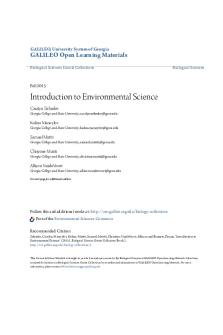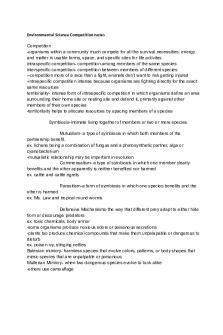Environmental Science Module 1 PDF

| Title | Environmental Science Module 1 |
|---|---|
| Author | Padaba Sorsogon |
| Course | Science Technology Information Technology |
| Institution | Polytechnic University of the Philippines |
| Pages | 4 |
| File Size | 63.7 KB |
| File Type | |
| Total Downloads | 35 |
| Total Views | 177 |
Summary
MODULE 1...
Description
SOLIS INSTITUTE OF TECHNOLOGY Managa – naga Bulan, Sorsogon
ENVIRONMENTAL SCIENCES MODULE 1 HUMANS are dependent on Earth’s water, Air and soil for our existence, however we have changed our planets in many ways, the Study of Environmental Science can help us understand how humans have changed our planet and how are we going to respond to it!
Environment: The sum of all the conditions surrounding us that influence life. Environmental science: The field that looks at interactions among humans and those found in nature. Ecosystem: A particular location on Earth with interacting biotic and abiotic components. Biotic: Living Abiotic: Nonliving
Environmental studies: The study of environmental science uses knowledge from many disciplines.
Humans alter natural systems.
Humans manipulate their environment more than any other species. .1 Introduction to Ecosystems In predator-prey relationships, the predator is an organism that eats another organism (the prey). Symbiosis is a close and long-term interaction between two species in an ecosystem. Types of symbiosis include mutualism, commensalism, and parasitism. Competition can occur within or between species in an ecosystem where there are limited resources. Resource partitioning— using the resources in different ways, places, or at different times—can reduce the negative impact of competition on survival. Biodiversity in an ecosystem includes genetic, species, and habitat diversity. The more genetically diverse a population is, the better it can respond to environmental stressors. Additionally, a population bottleneck can lead to a loss of genetic diversity. Ecosystems that have a larger number of species are more likely to recover from disruptions.
Loss of habitat leads to a loss of specialist species, followed by a loss of generalist species. It also leads to reduced numbers of species that have large territorial requirements. Species richness refers to the number of different species found in an ecosystem. Ecosystem Services (Modules 1, 29, 59, 65) There are four categories of ecosystem services: provisioning, regulating, cultural, and supporting. Anthropogenic activities can disrupt ecosystem services, potentially resulting in economic and ecological consequences. 5.12 Introduction to Sustainability (Modules 1, 2, 29, 33, 37, 66) Sustainability refers to humans living on Earth and their use of resources without depletion of the resources for future generations. Environmental indicators that can guide humans to sustainability include biological diversity, food production, average global surface temperatures and CO2 concentrations, human population, and resource depletion. Sustainable yield is the amount of a renewable resource that can be taken without reducing the available supply. Environment is derived from the French word Environner, which mean encircle or surrounding. Environment is a complex of many variables, which surrounds man as well as the living organisms. Environmental studies describe the interrelationships among organisms, the environment and all the factors, which influence life on earth, including atmospheric conditions, food chains, the water cycle, etc. It is a basic science about our earth and its daily activities, and therefore, this science is important for one and all. Scope of environmental studies Environmental studies discipline has multiple and multilevel scopes. This study is important and necessary not only for children but also for everyone. The scopes are summarized as follows: The study creates awareness among the people to know about various renewable and nonrenewable resources of the region. The endowment or potential, patterns of utilization and the balance of various resources available for future use in the state of a country are analysed in the study. It provides the knowledge about ecological systems and cause and effect relationships. It provides necessary information about biodiversity richness and the potential dangers to the species of plants, animals and microorganisms in the environment.
The study enables one to understand the causes and consequences due to natural and main induced disasters (flood, earthquake, landslide, cyclones etc.,) and pollutions and measures to minimize the effects. It enables one to evaluate alternative responses to environmental issues before deciding an alternative course of action. The study enables environmentally literate citizens (by knowing the environmental acts, rights, rules, legislations, etc.) to make appropriate judgments and decisions for the protection and improvement of the earth. The study exposes the problems of over population, health, hygiene, etc. and the role of arts, science and technology in eliminating/ minimizing the evils from the society The study tries to identify and develop appropriate and indigenous eco-friendly skills and technologies to various environmental issues. It teaches the citizens the need for sustainable utilization of resources as these resources are inherited from our ancestors to the younger generating without deteriorating their quality. The study enables theoretical knowledge into practice and the multiple uses of environment. Importance of environmental study Environmental study is based upon a comprehensive view of various environmental systems. It aims to make the citizens competent to do scientific work and to find out practical solutions to current environmental problems. The citizens acquire the ability to analyze the environmental parameters like the aquatic, terrestrial and atmospheric systems and their interactions with the biosphere and anthrosphere. Importance World population is increasing at an alarming rate especially in developing countries. The natural resources endowment in the earth is limited. The methods and techniques of exploiting natural resources are advanced. The resources are over-exploited and there is no foresight of leaving the resources to the future generations. The unplanned exploitation of natural resources lead to pollution of all types and at all levels. The pollution and degraded environment seriously affect the health of all living things on earth , including man. The people should take a combined responsibility for the deteriorating environment and begin to take appropriate actions to space the earth. Education and training are needed to save the biodiversity and species extinction.
The urban area, coupled with industries, is major sources of pollution. The number and area extinct under protected area should be increased so that the wild life is protected at least in these sites. The study enables the people to understand the complexities of the environment and need for the people to adapt appropriate activities and pursue sustainable development, which are harmonious with the environment. The study motivates students to get involved in community action, and to participate in various environmental and management projects It is a high time to reorient educational systems and curricula towards these needs. Environmental studies take a multidisciplinary approach to the study of human interactions with the natural environment. It integrates different approaches of the humanities , social sciences, biological sciences and physical sciences and applies these approaches to investigate environmental concerns. Environmental study is a key instrument for bringing about the changes in the knowledge, values, behaviors and lifestyles required to achieve sustainability and stability within and among countries. Environmental studies deals with every issue that affects an organism. It is essentially a multidisciplinary approach that brings about an appreciation of our natural world and human impacts on its integrity. It is an applied science as it seeks practical answers to making human civilization sustainable on the earth's finite resources. Its components include Biology Geology Chemistry Physics Engineering Sociology Health Anthropology Economics Statistics Philosophy...
Similar Free PDFs

Environmental Science Module 1
- 4 Pages

Environmental Science
- 16 Pages

Environmental Science and Engineering
- 109 Pages

Physical Science module 1
- 24 Pages

Environmental Science Midterm Review
- 17 Pages

Environmental Science Questions
- 52 Pages

Environmental Science Review Sheet
- 19 Pages

Earth Science Module 1
- 10 Pages

Environmental Science Lecture notes
- 25 Pages

Environmental Science English Only
- 10 Pages
Popular Institutions
- Tinajero National High School - Annex
- Politeknik Caltex Riau
- Yokohama City University
- SGT University
- University of Al-Qadisiyah
- Divine Word College of Vigan
- Techniek College Rotterdam
- Universidade de Santiago
- Universiti Teknologi MARA Cawangan Johor Kampus Pasir Gudang
- Poltekkes Kemenkes Yogyakarta
- Baguio City National High School
- Colegio san marcos
- preparatoria uno
- Centro de Bachillerato Tecnológico Industrial y de Servicios No. 107
- Dalian Maritime University
- Quang Trung Secondary School
- Colegio Tecnológico en Informática
- Corporación Regional de Educación Superior
- Grupo CEDVA
- Dar Al Uloom University
- Centro de Estudios Preuniversitarios de la Universidad Nacional de Ingeniería
- 上智大学
- Aakash International School, Nuna Majara
- San Felipe Neri Catholic School
- Kang Chiao International School - New Taipei City
- Misamis Occidental National High School
- Institución Educativa Escuela Normal Juan Ladrilleros
- Kolehiyo ng Pantukan
- Batanes State College
- Instituto Continental
- Sekolah Menengah Kejuruan Kesehatan Kaltara (Tarakan)
- Colegio de La Inmaculada Concepcion - Cebu





